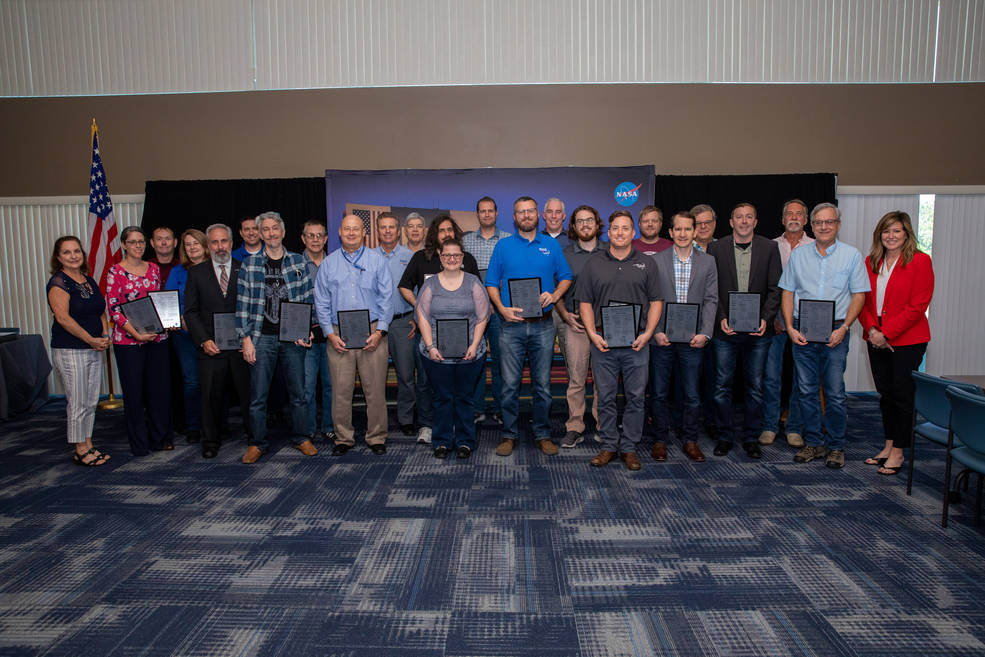
By Linda Herridge
NASA’s John F. Kennedy Space Center
Even throughout the pandemic, innovation continued to flourish at NASA’s Kennedy Space Center in Florida. From horticulture hardware to software development, the technologies created over the past few years are helping to solve the challenges of living and working in space while also helping those on Earth.
For the first time since 2018, the latest technologies at Kennedy were celebrated during the 2023 Innovator Recognition event on March 9. At the event, Kennedy leaders presented plaques to 25 NASA employees and seven contractor employees within the Launch Services Program, Engineering Directorate, and the Exploration Research and Technology Programs.
Since January 2020, there have been 151 new invention disclosures, also known as New Technology Reports (NTRs), from 146 NASA and contractor innovators.
Kennedy innovators included on eight or more NTRs from March 2020 to March 2022 were recognized: Jacob Torres; Gioia Massa, Ph.D.; Jeff Richards, Christina Johnson, Ph.D.; Griffin Lunn; and Tracy Gibson, Ph.D. Innovators included on five or more NTRs from the same years included Joel Olson, Ph.D.; Kenneth Engeling, Ph.D.; Ye Zhang, Ph.D.; Jim Mantovani, Ph.D.; LaShelle Spencer; Nathan Gelino; Oscar Monje, Ph.D.; and Dan Batcheldor, Ph.D.
Jacob Torres, an engineering plant scientist with Amentum on the Laboratory Support Services and Operations (LASSO) contract, develops and tests horticulture hardware for NASA’s Space Plant Biology flight experiments. He developed and tested the system for Plant Habitat-03 (PH-03) in the plant processing area of the Space Station Processing Facility.
Torres also is the co-inventor of the Passive Porous Tube Nutrient Delivery System, which is an all-environment passive plant irrigation system. “Meaning, it can grow plants in microgravity, on the Moon, Mars, or Earth,” Torres said. “Irrigation systems will allow NASA to pack a single system for all terrains, instead of one for microgravity and another for the Moon.”
The 2021 Best of KSC Software Competition winners also were recognized. The Mission category winner was the Spaceport Command and Control Systems that integrates NASA’s Space Launch System core stage, Orion spacecraft, and Interim Cryogenic Propulsion Stage with Kennedy’s ground systems to meet the processing and launch requirements for each Artemis mission. The Institutional category winner was the Secure Notification Application tool that securely enters, tracks, and reports Jacobs Test and Operations Support Contract personnel exposed to COVID-19.
The Quick Disconnect Device and the Miniaturized Electrospray System are a couple of Kennedy technologies that are poised to become spinoffs next year. The Quick Disconnect Device is a self-aligning, self-healing system for pneumatics and cryogenics that could be used to connect high-pressure fluid lines to vehicles that could also be quickly disconnected if needed. The Miniaturized Electrospray System could be used to precisely water aerospace crops. Spinoff highlights NASA technologies that benefit life on Earth in the form of commercial products.
Some technologies were found to have significant value in the conduct of aeronautical and space activities to receive Space Act Awards in 2022. These were the Environmental Test Chamber System (ETCS), Solar Radiance Reflective Coating, Miniaturized Aeroponic Electrosprayer, and the Close Location Access Wrench (CLAW).
The ETCS chambers are being used to investigate the effects of different environmental conditions to optimize plant growth, food safety, food quality, and nutrition for humans in space. The reflective coating may enable a future spacecraft to get close enough to the Sun, allowing it to sling shot around it and achieve speeds that would send humans to interstellar distances in reasonable time spans. The electrosprayer may help the success of crop production in space through proper control of air, water, and nutrients to plant root zones. The CLAW is an electrical connection spanner wrench device that enables the alignment, mating, and de-mating of connectors in tight areas not accessible to technicians’ hands.
Kennedy’s patent portfolio includes inventions in the areas of environmental remediation, cryogenics, materials, life sciences, information technology, and more. NASA’s patent portfolio contains more than 1,000 inventions. Read more at https://technology.nasa.gov/patents.




























